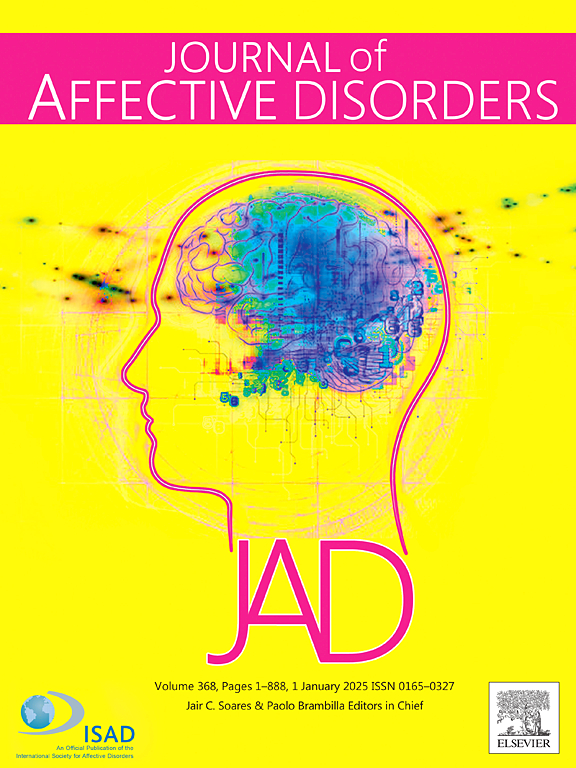Event-related potential alterations in bipolar disorder subtypes and mood states: Insights from an emotional visual task
IF 4.9
2区 医学
Q1 CLINICAL NEUROLOGY
引用次数: 0
Abstract
Background
Event-related potentials (ERPs) offer insights into neural mechanisms underlying bipolar disorder (BD), but their role as stable trait markers or state-dependent indicators remains unclear.
Methods
We examined six participant groups: healthy controls, individuals with BD I and II in depressed or euthymic states, and their unaffected siblings during an emotional visual task. Participants viewed images with negative, positive, or neutral emotional valence, each surrounded by a green or red frame. They were instructed to press a key matching the frame's color. EEG data were recorded, and effects of participant group and emotional valence on task performance and ERP characteristics (amplitude and latency) were evaluated using linear mixed-effects models, corrected for age and gender.
Results
Response time showed a significant group × condition interaction (Δχ2(22) = 34.33, p < 0.001), with predicted RTs from 579 ms (95 % CI: 452–743) for the BD_II euthymic group in the neutral condition to 829 ms (95 % CI: 732–940) for BD_I depressed participants in the negative condition; however, no post hoc differences remained significant after FDR correction. Early (N200) and late (LPP; 600–1000 ms) ERP amplitudes varied by condition, and P300 latency differed between groups, with unaffected siblings showing ERP alterations compared to controls.
Conclusion
BD, its subtypes, and mood states exert distinct effects on early and late ERP characteristics during emotional processing. These findings support the potential use of ERP features from emotional tasks as diagnostic markers for BD and highlight the complex interplay between trait and state factors in BD's neurophysiological profile.
双相情感障碍亚型和情绪状态的事件相关潜在改变:来自情感视觉任务的见解
事件相关电位(event -related potential, ERPs)为双相情感障碍(bipolar disorder, BD)的神经机制提供了深入的见解,但其作为稳定的性状标记或状态依赖指标的作用尚不清楚。方法我们检查了六组参与者:健康对照组,抑郁或心境的双相障碍I和II患者,以及他们在情绪性视觉任务中未受影响的兄弟姐妹。参与者观看带有消极、积极或中性情绪效价的图像,每幅图像都被绿色或红色边框包围。他们被指示按下与框架颜色相匹配的键。记录EEG数据,使用线性混合效应模型评估参与者组和情绪效价对任务表现和ERP特征(振幅和潜伏期)的影响,并对年龄和性别进行校正。结果反应时间组与条件交互作用显著(Δχ2(22) = 34.33, p <;0.001),预测RTs从中性条件下BD_I健康组的579 ms (95% CI: 452-743)到消极条件下BD_I抑郁组的829 ms (95% CI: 732-940);然而,经过FDR校正后,没有显著的事后差异。早期(N200)和晚期(LPP);600-1000 ms)的ERP振幅随条件的不同而变化,P300潜伏期在组间不同,未受影响的兄弟姐妹与对照组相比显示ERP改变。结论双相障碍及其亚型和情绪状态对情绪加工过程中ERP的早期和晚期特征有显著影响。这些发现支持了情绪任务的ERP特征作为双相障碍诊断标记的潜在用途,并强调了双相障碍神经生理特征中特征和状态因素之间复杂的相互作用。
本文章由计算机程序翻译,如有差异,请以英文原文为准。
求助全文
约1分钟内获得全文
求助全文
来源期刊

Journal of affective disorders
医学-精神病学
CiteScore
10.90
自引率
6.10%
发文量
1319
审稿时长
9.3 weeks
期刊介绍:
The Journal of Affective Disorders publishes papers concerned with affective disorders in the widest sense: depression, mania, mood spectrum, emotions and personality, anxiety and stress. It is interdisciplinary and aims to bring together different approaches for a diverse readership. Top quality papers will be accepted dealing with any aspect of affective disorders, including neuroimaging, cognitive neurosciences, genetics, molecular biology, experimental and clinical neurosciences, pharmacology, neuroimmunoendocrinology, intervention and treatment trials.
 求助内容:
求助内容: 应助结果提醒方式:
应助结果提醒方式:


